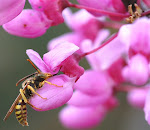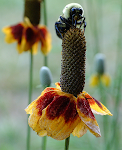Bee Colony Collapse Disorder: New Bait Lures Varroa Mite To Its Doom
Shared via AddThis
Colony Collapse Disorder is a huge concern in the world of beekeepers, farmers - and anyone who likes to eat. One third of our food crops are pollinated by, and thus dependent on, pollinators - honeybees included. All pollinators are declining in number, due to a host of things that people are doing (I could go into this at length but let's save this for a day when i am really cranky).
Honey bees in the past five years have begun to just vanish - something called Colony Collapse Disorder. The whole hive just disappears, no bodies on the ground, just all gone. And the experts are not sure why (though US EPA has recently (finally!) followed the EU in fingering pesticides as a big part of the problem).
Bees are stressed by chemicals used in agriculture, in home gardens, and in beekeeping itself. A common bane in the hive is the varroa mite - a nasty little flea-like thing that attaches itself to bees and their larvae and paracitizes them. Using miticides in hives to eliminate the mites contaminates the honey and is unhealthy for bees. It also builds up in beeswax such that now the commercially available beekeeping equipment, i.e. foundation, often contains traces of miticides. So even if you are trying to be an organic beekeeper the chemicals are present. I hate this.
There are efforts underway to manage mites using Integrated Pest Management approaches. One thing everyone around here does is use a screened bottom board so when the mites fall off the bees they fall down out of the hive and can't climb back in.
Thyme essential oil is known to repel the mites and there are other other plant-based techniques. Sprinkling frames with powered sugar causes the bees to groom extra hard and pull off mites. I haven't done any of these things yet, but these and the trap discussed in the attached article are good to know about.
Homemade Greek Yogurt
1 week ago




